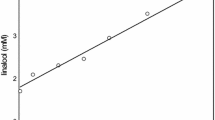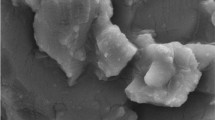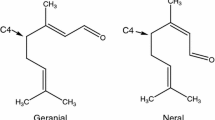Abstract
The physicochemical properties and thermodynamic parameters of cyclodextrin inclusion complexes (ICs) containing essential oil were investigated by thermogravimetric analysis. It is necessary to understand the ICs’ thermal decomposition behavior and kinetics to control and elucidate the inclusion complexation mechanisms. Carvacrol essential oil was encapsulated with hydroxypropyl-beta-cyclodextrin (HP-β CD) using the freeze-drying method. The IC was characterized by SEM, FT-IR, and phase solubility, which confirmed that there were molecular interactions between the carvacrol essential oil and HP-β CD. Moreover, thermal experiments were carried out by a thermogravimetric analyzer at different heating rates (10–40 °C min−1). In addition, three different models, i.e., FOW, KAS, and Starink, were used to calculate the kinetic energy. The FOW was a more proficient model for the calculation of activation energy (Ea). Further, the average values of Ea varied from conversion, and for carvacrol, HP-β CD, and carvacrol/HP-β CD IC, they were found to be 70.56, 162.15, and 152.57 kJ mol−1 based on the FOW model, respectively. In general, carvacrol encapsulated into HP-β CD as an IC showed high thermal stability. The kinetic results could be useful in predicting the thermal performance of IC and in helping optimize experimental procedures for the encapsulation of essential oils in cyclodextrins.
Graphical abstract








Similar content being viewed by others
References
Li Z, Wen WW, Chen XL, Zhu L, Cheng GS, Liao ZG, Huang H, Ming LS. Release characteristics of an essential oil component encapsulated with cyclodextrin shell matrices. Curr Drug Deliv. 2021;18:487–99. https://doi.org/10.2174/1567201817666200731164902.
Ming L, Huang H, Jiang Y, Cheng G, Zhang D, Li Z. Quickly identifying high-risk variables of ultrasonic extraction oil from multi-dimensional risk variable patterns and a comparative evaluation of different extraction methods on the quality of Forsythia suspensa seed oil. Molecules. 2019;24:3445. https://doi.org/10.3390/molecules24193445.
Galvão JG, Santos RL, Silva ARST, Santos JS, Costa AMB, Chandasana H, Andrade-Neto VV, Torres-Santos EC, Lira AAM, Dolabella S, Scher R, Kima P, Derrendorf H, Nunes RS. Carvacrol loaded nanostructured lipid carriers as a promising parenteral formulation for leishmaniasis treatment. Eur J Pharm Sci. 2020;150: 105335. https://doi.org/10.1016/j.ejps.2020.105335.
Dati LM, Ulrich H, Real CC, Feng ZP, Sun HS, Britto LR. Carvacrol promotes neuroprotection in the mouse hemiparkinsonian model. Neuroscience. 2017;356:176–81. https://doi.org/10.1016/j.neuroscience.2017.05.013.
Souza AG, Santos NMA, Torin RFdS, Rosa DdS. Synergic antimicrobial properties of Carvacrol essential oil and montmorillonite in biodegradable starch films. Int J Biol Macromol. 2020;164:1737–47. https://doi.org/10.1016/j.ijbiomac.2020.07.226.
Yildiz ZI, Celebioglu A, Kilic ME, Durgun E, Uyar T. Fast-dissolving carvacrol/cyclodextrin inclusion complex electrospun fibers with enhanced thermal stability, water solubility, and antioxidant activity. J Mater Sci. 2018;53:15837-49. https://doi.org/10.1007/s10853-018-2750-1.
Marinelli L, Fornasari E, Eusepi P, Ciulla M, Genovese S, Epifano F, Fiorito S, Turkez H, Örtücü S, Mingoia M, Simoni S, Pugnaloni A, Stefano AD, Cacciatore I. Carvacrol prodrugs as novel antimicrobial agents. Eur J Med Chem. 2019;178:515–29. https://doi.org/10.1016/j.ejmech.2019.05.093.
Shinde P, Agraval H, Srivastav AK, Yadav UCS, Kumar U. Physico-chemical characterization of carvacrol loaded zein nanoparticles for enhanced anticancer activity and investigation of molecular interactions between them by molecular docking. Int J Pharm. 2020;588:119795. https://doi.org/10.1016/j.ijpharm.2020.119795.
Mauriello E, Ferrari G, Donsì F. Effect of formulation on properties, stability, carvacrol release and antimicrobial activity of carvacrol emulsions. Colloid Surf B. 2021;197: 111424. https://doi.org/10.1016/j.colsurfb.2020.111424.
Cacciatore FA, Dalmás M, Maders C, Isaía HA, Brandelli A, Malheiros PdS. Carvacrol encapsulation into nanostructures: Characterization and antimicrobial activity against foodborne pathogens adhered to stainless steel. Food Res Int. 2020;133:109143. https://doi.org/10.1016/j.foodres.2020.109143.
Niza E, Božik M, Bravo I, Clemente-Casares P, Lara-Sanchez A, Juan A, Klouček P, Alonso-Moreno C. PEI-coated PLA nanoparticles to enhance the antimicrobial activity of carvacrol. Food Chem. 2020;328: 127131. https://doi.org/10.1016/j.foodchem.2020.127131.
Santos EH, Kamimura JA, Hill LE, Gomes CL. Characterization of carvacrol beta-cyclodextrin inclusion complexes as delivery systems for antibacterial and antioxidant applications. LWT. 2015;60:583–92. https://doi.org/10.1016/j.lwt.2014.08.046.
Yuan C, Jin Z, Xu X. Inclusion complex of astaxanthin with hydroxypropyl-beta-cyclodextrin: UV, FTIR, 1H NMR and molecular modeling studies. Carbohydr Polym. 2012;89:492–6. https://doi.org/10.1016/j.carbpol.2012.03.033.
Liu DD, Guo YF, Zhang JQ, Yang ZK, Li X, Yang B, Yang R. Inclusion of lycorine with natural cyclodextrins (α-, β- and γ-CD): Experimental and in vitro evaluation. J Mol Struct. 2017;1130:669–76. https://doi.org/10.1016/j.molstruc.2016.11.018.
Su Z, Qin Y, Zhang K, Bi Y, Kong F. Inclusion complex of exocarpium citri grandis essential oil with beta-cyclodextrin: Characterization, stability, and antioxidant activity. J Food Sci. 2019;84:1592–9. https://doi.org/10.1111/1750-3841.14623.
Chew SC, Tan CP, Nyam KL. Microencapsulation of refined kenaf (Hibiscus cannabinus L.) seed oil by spray drying using β-cyclodextrin/gum arabic/sodium caseinate. J Food Eng. 2018;237:78–85. https://doi.org/10.1016/j.jfoodeng.2018.05.016.
Costa MDS, Rocha JE, Campina FF, Silva ARP, Da Cruz RP, Pereira RLS, Quintans-Júnior LJ, Menezes ID, Araújo AADS, Freitas TSD, Teixeira AMR, Coutinho HDM. Comparative analysis of the antibacterial and drug-modulatory effect of d-limonene alone and complexed with β-cyclodextrin. Eur J Pharm Sci. 2019;128:158–61. https://doi.org/10.1016/j.ejps.2018.11.036.
Chen H, Li L, Ma Y, McDonald TP, Wang Y. Development of active packaging film containing bioactive components encapsulated in β-cyclodextrin and its application. Food Hydrocoll. 2019;90:360–6. https://doi.org/10.1016/j.foodhyd.2018.12.043.
Niu Y, Deng J, Xiao Z, Kou X, Zhu G, Liu M, Liu S. Preparation and slow release kinetics of apple fragrance/β-cyclodextrin inclusion complex. J Therm Anal Calorim. 2020;143:3775–81. https://doi.org/10.1007/s10973-020-09292-9.
Rakmai J, Cheirsilp B, Mejuto JC, Simal-Gándara J, Torrado-Agrasar A. Antioxidant and antimicrobial properties of encapsulated guava leaf oil in hydroxypropyl-beta-cyclodextrin. Ind Crop Prod. 2018;111:219–25. https://doi.org/10.1016/j.indcrop.2017.10.027.
Zhong Y, Li W, Ran L, Hou R, Han P, Lu S, Wang Q, Zhao W, Dong J. Inclusion complexes of tea polyphenols with HP-β-cyclodextrin: preparation, characterization, molecular docking, and antioxidant activity. J Food Sci. 2020;85:1105–13. https://doi.org/10.1111/1750-3841.15083.
Pires FQ, da Silva JKR, Sa-Barreto LL, Gratieri T, Gelfuso GM, Cunha-Filho M. Lipid nanoparticles as carriers of cyclodextrin inclusion complexes: a promising approach for cutaneous delivery of a volatile essential oil. Colloid Surf B. 2019;182: 110382. https://doi.org/10.1016/j.colsurfb.2019.110382.
Rakmai J, Cheirsilp B, Mejuto JC, Torrado-Agrasar A, Simal-Gándara J. Physico-chemical characterization and evaluation of bio-efficacies of black pepper essential oil encapsulated in hydroxypropyl-beta-cyclodextrin. Food Hydrocoll. 2017;65:157–64. https://doi.org/10.1016/j.foodhyd.2016.11.014.
Baser KHC. Biological and pharmacological activities of carvacrol and carvacrol bearing essential oils. Curr Pharm Des. 2008;14:3106–20. https://doi.org/10.2174/138161208786404227.
Scremin FR, Veiga RS, Silva-Buzanello RA, Becker-Algeri TA, Corso MP, Torquato AS, Bittencourt PPS, Flores ELM, Canna C. Synthesis and characterization of protein microcapsules for eugenol storage. J Therm Anal Calorim. 2017;131:653–60. https://doi.org/10.1007/s10973-017-6302-8.
He D, Deng P, Yang L, Tan Q, Liu J, Yang M, Zhang J. Molecular encapsulation of rifampicin as an inclusion complex of hydroxypropyl-beta-cyclodextrin: design; characterization and in vitro dissolution. Colloids Surf B. 2013;103:580–5. https://doi.org/10.1016/j.colsurfb.2012.10.062.
Ahuja N, Katare OP, Singh B. Studies on dissolution enhancement and mathematical modeling of drug release of a poorly water-soluble drug using water-soluble carriers. Eur J Pharm Biopharm. 2007;65:26–38. https://doi.org/10.1016/j.ejpb.2006.07.007.
Kabirov D, Silvestri T, Niccoli M, Usacheva T, Mayol L, Biondi M, Giancola C. Phase solubility and thermoanalytical studies of the inclusion complex formation between curcumin and hydroxypropyl-β-cyclodextrin in hydroalcoholic solutions. J Therm Anal Calorim. 2020. https://doi.org/10.1007/s10973-020-10381-y.
Prabu S, Sivakumar K, Nayaki SK, Rajamohan R. Host-guest interaction of cytidine in β-cyclodextrin microcavity: characterization and docking study. J Mol Liq. 2016;219:967–74. https://doi.org/10.1016/j.molliq.2016.04.017.
Lin L, Zhu Y, Thangaraj B, Abdel-Samie MAS, Cui H. Improving the stability of thyme essential oil solid liposome by using beta-cyclodextrin as a cryoprotectant. Carbohydr Polym. 2018;188:243–51. https://doi.org/10.1016/j.carbpol.2018.02.010.
Ming L, Li Z, Wu F, Du R, Feng Y. A two-step approach for fluidized bed granulation in pharmaceutical processing: assessing different models for design and control. PLoS ONE. 2017;12: e0180209. https://doi.org/10.1371/journal.pone.0180209.
Kringel DH, Antunes MD, Klein B, Crizel RL, Wagner R, de Oliveira RP,Dias ARG, Zavareze EdR. Production, characterization, and stability of orange or eucalyptus essential oil/beta-cyclodextrin inclusion complex. J Food Sci. 2017;82:2598–605. https://doi.org/10.1111/1750-3841.13923.
Li Z, Jiang X, Yao Z, Chen F, Zhu L, Liu H, Ming L. Chitosan functionalized cellulose nanocrystals for stabilizing Pickering emulsion: fabrication, characterization and stability evaluation. Colloid Surf A. 2022;632: 127769. https://doi.org/10.1016/j.colsurfa.2021.127769.
Liu SH, Hou HY, Chen JW, Weng SY, Lin YC, Shu CM. Effects of thermal runaway hazard for three organic peroxides conducted by acids and alkalines with DSC, VSP2, and TAM III. Thermochim Acta. 2013;566:226–32. https://doi.org/10.1016/j.tca.2013.05.029.
Mishra RK, Mohanty K. Kinetic analysis and pyrolysis behaviour of waste biomass towards its bioenergy potential. Bioresour Technol. 2020;311: 123480. https://doi.org/10.1016/j.biortech.2020.123480.
Ferrara F, Orsini A, Plaisant A, Pettinau A. Pyrolysis of coal, biomass and their blends: performance assessment by thermogravimetric analysis. Bioresour Technol. 2014;171:433–41. https://doi.org/10.1016/j.biortech.2014.08.104.
Kaur R, Gera P, Jha MK, Bhaskar T. Pyrolysis kinetics and thermodynamic parameters of castor (Ricinus communis) residue using thermogravimetric analysis. Bioresour Technol. 2018;250:422–8. https://doi.org/10.1016/j.biortech.2017.11.077.
Singh RK, Pandey D, Patil T, Sawarkar AN. Pyrolysis of banana leaves biomass: physico-chemical characterization, thermal decomposition behavior, kinetic and thermodynamic analyses. Bioresour Technol. 2020;310: 123464. https://doi.org/10.1016/j.biortech.2020.123464.
Gao S, Jiang J, Li X, Liu Y, Zhao L, Fu Y, Ye F. Enhanced physicochemical properties and herbicidal activity of an environment-friendly clathrate formed by β-cyclodextrin and herbicide cyanazine. J Mol Liq. 2020;305: 112858. https://doi.org/10.1016/j.molliq.2020.112858.
Nguyen TA, Liu B, Zhao J, Thomas DS, Hook JM. An investigation into the supramolecular structure, solubility, stability and antioxidant activity of rutin/cyclodextrin inclusion complex. Food Chem. 2013;136:186–92. https://doi.org/10.1016/j.foodchem.2012.07.104.
Pires FQ, Pinho LA, Freire DO, Silva ICR, Sa-Barreto LL, Cardozo-Filho L, Gratieri T, Gelfuso GM, Cunha-Filho M. Thermal analysis used to guide the production of thymol and Lippia origanoides essential oil inclusion complexes with cyclodextrin. J Therm Anal Calorim. 2018;137:543–53. https://doi.org/10.1007/s10973-018-7956-6.
Li X, Bai Y, Ji H, Jin Z. The binding mechanism between cyclodextrins and pullulanase: a molecular docking, isothermal titration calorimetry, circular dichroism and fluorescence study. Food Chem. 2020;321: 126750. https://doi.org/10.1016/j.foodchem.2020.126750.
Wang J, Cao Y, Sun B, Wang C. Characterisation of inclusion complex of trans-ferulic acid and hydroxypropyl-β-cyclodextrin. Food Chem. 2011;124:1069–75. https://doi.org/10.1016/j.foodchem.2010.07.080.
Gao S, Liu Y, Jiang J, Ji Q, Fu Y, Zhao L, Li C, Ye F. Physicochemical properties and fungicidal activity of inclusion complexes of fungicide chlorothalonil with β-cyclodextrin and hydroxypropyl-β-cyclodextrin. J Mol Liq. 2019;293: 111513. https://doi.org/10.1016/j.molliq.2019.111513.
Łopusiewicz Ł, Kwiatkowski P, Drozłowska E, Trocer P, Kostek M, Śliwiński M, Polak-Śliwińska M, Kowalczyk E, Sienkiewicz M. Preparation and characterization of carboxymethyl cellulose-based bioactive composite films modified with fungal melanin and carvacrol. Polymers. 2021;13:499. https://doi.org/10.3390/polym13040499.
Cheng M, Wang J, Zhang R, Kong R, Lu W, Wang X. Characterization and application of the microencapsulated carvacrol/sodium alginate films as food packaging materials. Int J Biol Macromol. 2019;141:259–67. https://doi.org/10.1016/j.ijbiomac.2019.08.215.
Wei Y, Zhang J, Zhou Y, Bei W, Li Y, Yuan Q, Liang H. Characterization of glabridin/hydroxypropyl-β-cyclodextrin inclusion complex with robust solubility and enhanced bioactivity. Carbohydr Polym. 2017;159:152–60. https://doi.org/10.1016/j.carbpol.2016.11.093.
Yang Y, Gao J, Ma X, Huang G. Inclusion complex of tamibarotene with hydroxypropyl-β-cyclodextrin: preparation, characterization, in-vitro and in-vivo evaluation. Asian J Pharm Sci. 2017;12:187–92. https://doi.org/10.1016/j.ajps.2016.08.009.
Sattar H, Muzaffar I, Munir S. Thermal and kinetic study of rice husk, corn cobs, peanut crust and Khushab coal under inert (N2) and oxidative (dry air) atmospheres. Renew Energ. 2020;149:794–805. https://doi.org/10.1016/j.renene.2019.12.020.
Boubacar Laouge Z, Merdun H. Pyrolysis and combustion kinetics of Sida cordifolia L. using thermogravimetric analysis. Bioresour Technol. 2020;299:122602. https://doi.org/10.1016/j.biortech.2019.122602.
Ceylan S, Topçu Y. Pyrolysis kinetics of hazelnut husk using thermogravimetric analysis. Bioresource Technol. 2014;156:182–8. https://doi.org/10.1016/j.biortech.2014.01.040.
Acknowledgements
This study was funded by the National Natural Science Foundation of China (Grant No. 82003953), Natural Science Foundation of Jiangxi Province (Grant No. 20202BAB216039 and 20212BAB216009), Science and Technology Project of Education Department of Jiangxi Province (Grant No. GJJ190688 and GJJ201252), Science and Technology Research Project of Jiangxi Administration of Traditional Chinese medicine (2021A327), 2020-2022 Young Talents Support Project of Chinese Society of Chinese Medicine (2020-QNRC2-07).
Author information
Authors and Affiliations
Contributions
ZL performed conceptualization. XJ, LZ and FC were involved in data curation. XJ was involved in writing—original draft preparation. FC performed investigation. HL was involved in writing—reviewing. LM performed supervision.
Corresponding author
Ethics declarations
Conflict of interest
The authors declare that they have no conflict of interest.
Additional information
Publisher's Note
Springer Nature remains neutral with regard to jurisdictional claims in published maps and institutional affiliations.
Supplementary Information
Below is the link to the electronic supplementary material.
Rights and permissions
About this article
Cite this article
Li, Z., Jiang, X., Zhu, L. et al. New insights into the thermal degradation behavior of Hydroxypropyl-beta-cyclodextrin inclusion complexes containing carvacrol essential oil via thermogravimetric analysis. J Therm Anal Calorim 147, 11301–11312 (2022). https://doi.org/10.1007/s10973-022-11327-2
Received:
Accepted:
Published:
Issue Date:
DOI: https://doi.org/10.1007/s10973-022-11327-2




